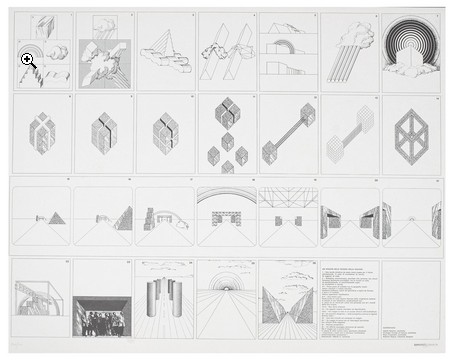- ArtistsDESKTOP
- Carla Accardi
- Lucio Del Pezzo
- Achille Perilli
- Afro Libio Basaldella
- Piero Dorazio
- Peter Phillips
- Getulio Alviani
- Sergio Fermariello
- Gianni Piacentino
- Fernandez Arman
- Lucio Fontana
- Pino Pinelli
- Arte Concreta svizzera
- Piero Gilardi
- Michelangelo Pistoletto
- Enrico Baj
- Giorgio Griffa
- Arnaldo Pomodoro
- Davide Benati
- Hans Hartung
- Mel Ramos
- Joseph Beuys
- Emilio Isgrò
- Man Ray
- Alighiero Boetti
- Jannis Kounellis
- Mimmo Rotella
- Agostino Bonalumi
- Urs Lüthi
- Salvo
- Alberto Burri
- Esther Mahlangu
- Giuseppe Santomaso
- Antonio Calderara
- Marino Marini
- Mario Schifano
- Giuseppe Capogrossi
- Paolo Masi
- Ettore Spalletti
- Enrico Castellani
- Roberto Sebastian Matta
- Jesús Rafael Soto
- Mario Ceroli
- François Morellet
- Superstudio
- Sandro Chia
- Bruno Munari
- Antoni Tàpies
- Javacheff Christo
- Mimmo Paladino
- Tilson Joe
- Giorgio de Chirico
- Giulio Paolini
- Gilberto Zorio
- ArtistsMOBILE
- Carla Accardi
- Afro Libio Basaldella
- Getulio Alviani
- Fernandez Arman
- Enrico Baj
- Davide Benati
- Joseph Beuys
- Alighiero Boetti
- Agostino Bonalumi
- Alberto Burri
- Antonio Calderara
- Giuseppe Capogrossi
- Enrico Castellani
- Mario Ceroli
- Sandro Chia
- Javacheff Christo
- Giorgio de Chirico
- Lucio Del Pezzo
- Piero Dorazio
- Sergio Fermariello
- Lucio Fontana
- Piero Gilardi
- Giorgio Griffa
- Hans Hartung
- Emilio Isgrò
- Jannis Kounellis
- Urs Lüthi
- Esther Mahlangu
- Marino Marini
- Paolo Masi
- Roberto Sebastian Matta
- François Morellet
- Bruno Munari
- Mimmo Paladino
- Giulio Paolini
- Achille Perilli
- Peter Phillips
- Gianni Piacentino
- Pino Pinelli
- Michelangelo Pistoletto
- Arnaldo Pomodoro
- Mel Ramos
- Man Ray
- Mimmo Rotella
- Salvo
- Giuseppe Santomaso
- Mario Schifano
- Ettore Spalletti
- Jesús Rafael Soto
- Superstudio
- Antoni Tàpies
- Joe Tilson
- Zurich Concretists
- Gilberto Zorio
- The gallery
- Exhibitions
- Fairs
- Acquisitions
- News
- Contact
- IT
- EN
Artist:
Artist:
Category:
print
Title:
Viaggio nelle regioni della ragione
Year:
1970
Technique:
lithograph
Dimension:
69 x 87 cm
Plate dimension:
Edition:
500 + XX ex.
Editor:
Plura Edizioni, Milano
Notes:
hand signed and numbered
Publications:
Available:
YES
Price:
690€
Work
CONTACT US FOR INFORMATION
Are you interested in the work?
Fill in the contact form and you will be contacted.
Fill in the contact form and you will be contacted.
Send your request
-
Superstudio was an architecture firm, founded in 1966 in Florence, Italy by Adolfo Natalini and Cristiano Toraldo di Francia, later joined by G. Piero Frassinelli, Alessandro and Roberto Magris, Alessandro Poli. Superstudio was a major part of the Radical architecture and design movement of the late 1960s.
In 1969, Superstudio presented one of their most famous conceptual architecture works – Continuous Monument: An Architectural Model for Total Urbanization. Their anti-architectural proposals used grid systems as a way to mediate space. Superstudio aimed for social change through architecture.
In 1970, they created their iconic minimalist furniture collection – Quaderna, which is still in production by Zanotta. Superstudio took part in the MoMA exhibition “Italy: The New Domestic Landscape” (1972). Critics agree that the work of Superstudio was influential, or even entirely inspirational to, among others, architects like Zaha Hadid, Rem Koolhaas and Bernard Tschumi.
Evidence of this is notable when one considers that the use of strong symmetrical line-work and geometric form; mediums heavily utilized by all of these architects, were staples of Superstudio’s work throughout most of its life. Superstudio abandoned working as a collective in 1978, but its members continued to develop their ideas independently through their writings, via education, architectural practice and other design projects.
© 2024 SANGALLO FINE ART | viale Gabriele D’Annunzio, 46/B – 66054 Vasto (CH), Italia | Tel +39 3385677066 | P.IVA IT 02616880692 | Email info@sangallofineart.it
Subscribe to our newsletter
